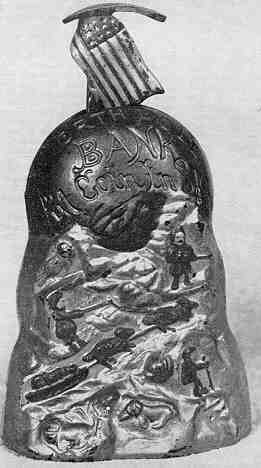North Pole Bank
by F.H. Griffith - HOBBIES Magazine - July, 1954
 A number of the mechanical banks were made to represent certain individuals,
and in some cases, their connection with a historical event or an event of interest. The
North Pole Bank, No. 30 in our numerical classification, commemorates the discovery of the
North Pole and was made at the time of the Peary-Cook controversy. Either Peary or Cook
could be identified with the bank and it was apparently made this way so it could be sold
to individuals on either side of the controversy.
A number of the mechanical banks were made to represent certain individuals,
and in some cases, their connection with a historical event or an event of interest. The
North Pole Bank, No. 30 in our numerical classification, commemorates the discovery of the
North Pole and was made at the time of the Peary-Cook controversy. Either Peary or Cook
could be identified with the bank and it was apparently made this way so it could be sold
to individuals on either side of the controversy.
The North Pole Bank was patented by Charles A. Bailey of Cromwell, Conn., July 6, 1910, and manufactured by the J. and E. Stevens Company also of Cromwell. Apparently, it was felt at the time that this bank would be a good seller, but it certainly doesn’t seem to have been the case as indicated by the relative few that have turned up so far. Of course it’s to be admitted that mechanical banks had passed their peak of popularity by 1910 and many of these later banks are the hardest to find today.
The bank pictured is from the fine collection of Mr. L.C. Hegarty and was found in New England a few years ago. It is in perfect original condition with no repairs and the paint is excellent. The lower part of the bank is painted in aluminum and the upper part is a bronze gold color. Inscribed on the upper part of the bank is the wording "North Pole Bank—Put Coin In Slot." The American flag is painted realistically with red an white stripes. As can be seen in the picture, the bank is decorated with a number of eskimos, seals, walrus, sleds, and the like. These are painted in gold tan and white.
From an operation standpoint, the bank is not particularly spectacular, but still the action is very appropriate and interesting. The picture shows the bank after the action has taken place. To operate, the flag is pushed down manually and it clicks into place inside the bank. In the left side of the bank (the viewer’s right side) there is a coin slot. The coin is pushed into this slot and the flag pops up as shown. Coins are removed by the conventional type round Stevens’ coin trap.
As mentioned at the beginning some banks are identified with an individual or are a personal caricature. In some cases this individual is also connected with a historical or special interest event. An example of this is the World’s Fair Bank. This bank commemorates the World’s Fair and also Columbus and the discovery of America. After the World’s Fair it was made without the name "World’s Fair" imprinted on it. Of course, it still represented Columbus and the discovery of America.
In the case of the North Pole Bank, it is an example of a lack of any personal identity with an individual, but it still represents a historical event and you could choose your own hero, Peary or Cook.
The North Pole Bank may have simple action but it is a difficult bank to find and a fine addition to any collection.
